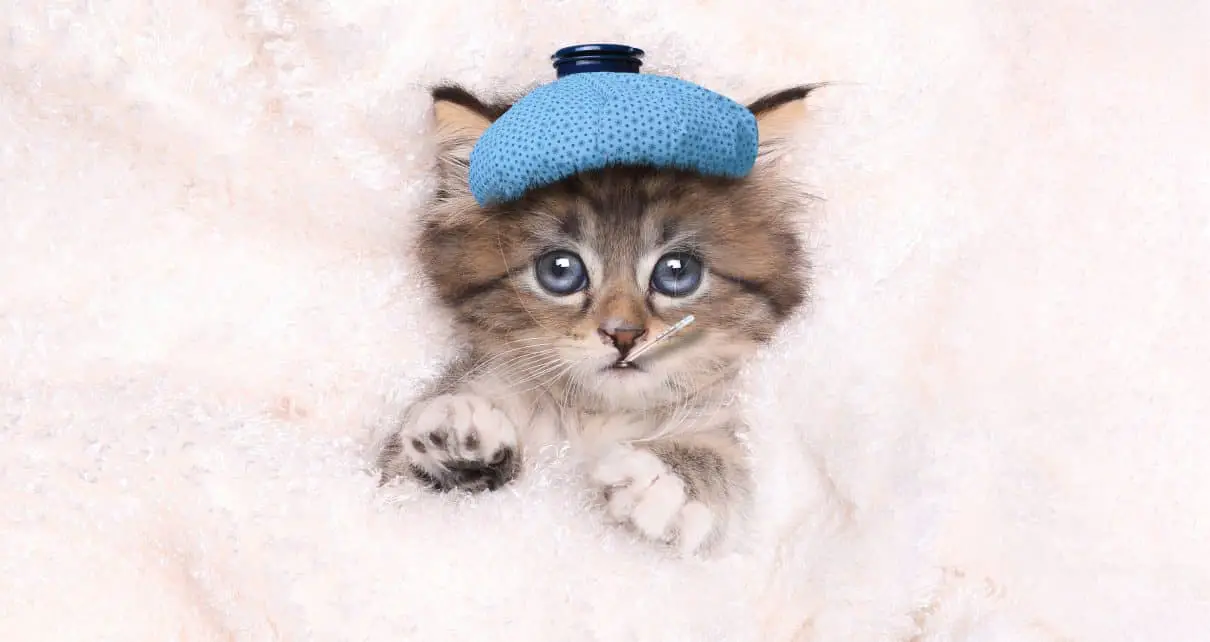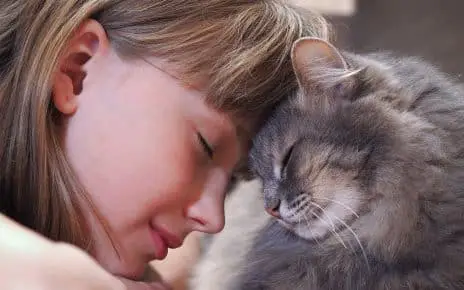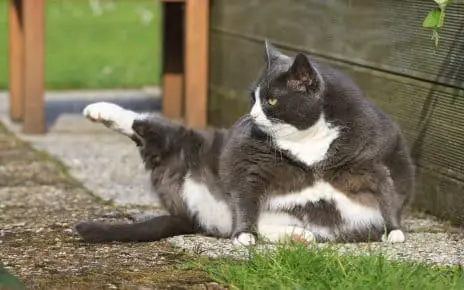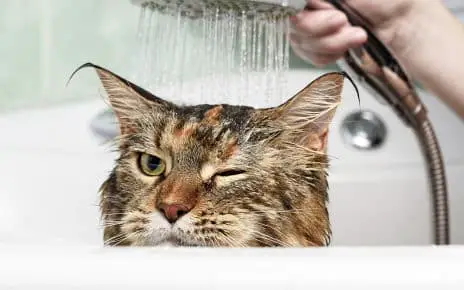The weather outside is frightful and your cat has been feeling less than delightful. She’s sneezing an awful lot lately and there’s some kind of funky discharge coming out of her nose and eyes. She’s breathing through her mouth as well, which you’ve never seen her do before.
Reminds you an awful lot of what you went through recently during flu season…is it possible that your cat caught your cold?
Can Cats Get Colds
Yes, dear human – cats can catch colds. The cat version of a cold is called feline upper respiratory disease and it’s actually pretty common, just like the common cold is for us humans.
The good news for you (and your guilt) is that your cat certainly did not get it from you. The most common cause for a human cold is a rhinovirus, while cat colds are usually caused by feline herpes virus or calicivirus.
So if both you and your cat are feeling under the weather, feel free to keep each other company without worrying whether you’ll catch one another’s cold.
How to Tell if Your Cat Has a Cold
The most common reason to suspect a cat cold is sneezing. But not every sneeze is cause for alarm. Even if your cat has been awfully sneezy lately, it could be due to dust bunnies or even the dust from their litter box. Some cats also suffer from their own version of seasonal allergies so if it’s springtime, you’ll just have to wait ’til the flowers have finished blooming.
But if your cat is sneezing excessively and displaying one or more of the following cat cold symptoms, it might be time to schedule a visit to the vet.
Common Cat Cold Symptoms:
- Excessive sneezing
- Excessive coughing
- Nose and eye discharge
- Ulcers in nose, eyes, or mouth
- Fever
- Loss of appetite, refusing favorite foods
- Dehydration
- Congestion and mouth breathing
Your vet can test cultures taken from affected areas in the nose, mouth and throat for the presence of viruses that cause feline upper respiratory disease. He may give you medication designed to boost your cat’s immune system and interfere with the reproduction of herpesvirus.
If you want to make treatment painless and the cold isn’t bad enough that the cat is refusing food, be sure to ask for this in the form of a cream with an attractive scent and taste that you can squirt on your cat’s food. Your vet may also give you an antibiotic to help your cat fight off secondary infections like pneumonia.
What to Do if Your Cat Has a Cold
Watching your beloved cat suffer from a cold is tough, but the good news is that most cat colds are generally not serious and only last at most seven to ten days.
So the best thing you can do in the meantime is to make sure your cat is getting plenty of rest, food and liquids to help her recover from the cold.
An apparent loss of appetite may mean that your cat can’t smell her food and she may refuse to eat even her favorite treats if the cold is bad enough. You probably dislike the idea of force-feeding a cat, so try a simple tip like heating up canned food. The warmth intensifies the scent, which can help entice your cat and encourage her to eat.
It’s especially important to keep your cat warm and dry. Cats prefer temperatures above 70 degrees even when they’re not sick. If your cat gets wet (which will usually be because she had an accident), dry her off with a towel or hair dryer on low power or make sure to keep her in a warm place while she dries off.
If you can place a space heater in the area where your cat normally sleeps or this can also help prevent chills while your cat recovers.
Lastly, keep in mind that although most cat colds aren’t serious, the virus that caused the cold never completely leaves your cat’s system, even with treatment. That can lead to recurring sickness or even a more serious secondary infection so be sure to monitor your cat closely for signs of recovery or worsening symptoms.
Home Remedies for Cat Colds
As discussed above if your kitty is sneezing or coughing excessively, has discharge, high fever or any other alarming symptoms, you should take your kitty to the vet for professional care to rule out anything more serious. Also seniors, kittens and cats with an impaired immune system are at higher risk so need extra attention.
The good news is that you can’t catch your cat’s cold – or vice versa. Human colds and cat colds are caused by different viruses so feel free to snuggle up to kitty while she goes through a week of cat cold hell.
Warm Up the Cat Food
Cats – like humans – tend to lose their appetite when they’re sick. But in order to get better quick, they absolutely need the nutrition!
If your cat is uninterested in all things food, it can be because their congested sinuses prevent them from smelling the yumminess. So get out the good stuff – canned food in their favorite flavor – and warm it up to release the scent and stimulate his appetite.
Offer Human Foods Cats Can’t Resist
You can also try offering her more tempting, human foods during her cold.
My cat loves chicken soup when she’s sick as well as beef stew, a soft fish stew and scrambled eggs. Just make absolutely sure the human food you give your cat does not contain onions, garlic, mushrooms, yeast dough, citruses or any other human foods cats can’t eat. We have an article on dangerous foods for cats here.
Oh, and make sure to switch kitty back to her own food as soon as she gets better, no matter how much she demands otherwise!
Hand Feed Your Cat
Your cat is feeling under the weather and reluctant to even get up from his cozy cat bed and wander on over his bowl. So why not bring the food.
Try scooping up a small amount of moistened or wet cat food between your fingers and placing it on your cat’s tongue. You can also go for a feeding syringe to gently make sure your cat is getting enough to eat without forcing the food down.
Nutrients in a Tube
If your cat is entirely uninterested in eating, it might take a little more than coaxing. If you absolutely can’t encourage him to eat, your best option is to get a high-calorie, high-nutrition paste to make sure your cat is getting enough nutrition to help him recover faster
Prevent Dehydration
f your cat isn’t eating, he’s probably also not visiting his water bowl too often. Cat dehydration is a common side effect of the cat cold so you may want to bring the water to him.
And easy way to check for signs of cat dehydration is to pinch a your cat’s skin on the back of his neck. Pull it up gently and then let go. If it snaps back immediately, he’s fine and hydrated. If it goes down slowly, he needs more fluids in his body.
Again, chicken, beef or fish stew (basically just the meats stewed in water to create a soft broth) is a good way to give your cats both nutrients and water in one go. So is canned cat food.
Wipe Away the Evidence
Cat colds cause discharge. And poor kitty can’t just blow her nose like we can.
The best way to help her out with all the gunk her body is discharging during the cold is to keep a pack of cat wipes handy to gently remove eye any nasal discharge.
She might not appreciate the gesture – my cat hates having her face cleaned by anything other than her own paws – but she’ll appreciate the lack of runny gunk on her face, hopefully.
Clear the Congestion
That icky, frustrating congested feeling in the nose and chest is probably the worst part of the common cold for most of us – and it’s no different for your cat. I mean, have you ever seen your cat breathe through her mouth by choice.
You can help kitty breathe better by ramping up the humidity. A good humidifier definitely helps. If you don’t have one and like hot showers, let your cat come into the bathroom with you so the steam can help her breathe better. You can also get nasal drops for your cat to clear the congestion.
Keep Your Cat Warm
Cats prefer temperatures above 70 degrees even when they’re not sick. But when your cat is sick and possibly feverish, it’s more important than ever to keep her warm and toasty.
Move her beds and lounging spaces away from the windows or anywhere that’s drafty and set her up with a blanket or space heater so she can keep warm.
How Can You Prevent Cat Colds
If you have multiple cats and one of them starts developing a case of the sniffles,? isolate that cat from the other cats so that the infection won’t spread. (Yes, even if the cat is used to having the run of the house and gives you a fight over being quarantined!)
Your cats should always have access to clean food and water and a clean litter box. Your house should also be kept clean to prevent an environment in which germs can breed. If you hate housekeeping, you might consider obtaining a Roomba that is pretty good at sweeping up pet hair.
Your house should be kept above 70 degrees so your cats won’t catch chills, especially during the winters. And if you give your cat a bath or if they get wet for any reason, dry them off as quickly as possible. You might also consider asking your vet about vaccines that can prevent infections.
Colds usually aren’t all that serious, especially if you can create an environment in which your cat won’t catch an infection all that often and seek treatment as soon as possible when she does catch a cold. If you suspect that it might be something other than a simple cold or you don’t want your cat suffer more than necessary from a cold, be sure to take your cat to the vet right away when you start noticing symptoms.



